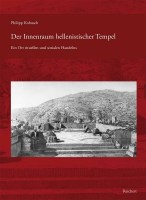Search
Der Innenraum hellenistischer Tempel
Ein Ort rituellen und sozialen Handelns
2022
21.0 x 29.7 cm, 368 p., 261 illustrations b/w, 45 Tafeln, 1 Beilage, hardback
ISBN: 9783752000092
go to ebook version
21.0 x 29.7 cm, 368 p., 261 illustrations b/w, 45 Tafeln, 1 Beilage, hardback
118,00 €
ISBN: 9783752000092
go to ebook version
Short Description
The erection of Greek temples was one of the most important building tasks in antiquity. Yet despite over 150 years of academic research on these buildings, their use for cultic and social purposes is almost unknown. This monograph is the first to examine this question systematically on the basis of both the relevant archaeological evidence of the Late Classical and Hellenistic periods in Greece and Asia Minor and the available written tradition. It can be shown that temple interiors were regularly integrated into the cultic processes of the sanctuary and often represented a central space for sacrifice and prayer. At the same time, they were actively used for multi-layered social interaction. However, no cross-cultural mode of use can be grasped. Instead, each temple was inscribed with an individual concept of use according to local requirements. Each Greek temple was therefore unique, not only architecturally, but also in its forms of use.Description
Since the beginning of academic interest in Greek culture, a special focus in research has been on Greek temple buildings. Nevertheless, until well into the 2000s, their significance in Greek ritual was often categorically denied: The architecture of the temples was understood merely as a façade in front of which the central rituals at the altar took place outside the temple itself. Their interiors were simply regarded as storage places for the cult image, which remained inaccessible to a broader public.It is only since the late 1990s that this picture has been sporadically questioned in ancient studies, but always only on the basis of limited evidence. The present study is the first to compile the archaeologically verifiable functional objects from temple interiors on the one hand and the actions that have been described in written sources on the other. This interdisciplinary approach provides a solid basis for evaluating the spectrum of uses of Greek temple interiors.
The underlying premise for a study of temples as a space for action is that they can be entered by a broad public as a matter of course. This thesis can be proven without a doubt by a large number of literary and epigraphic sources that have been systematically compiled here for the first time.
The study shows that temple interiors were a central place for (ritual) communication with the deity. Besides prayers, this also included specific forms of sacrifice that took place parallel to and in addition to the main sacrifice at the altar. Archaeological evidence of this use can be found in the form of permanently installed sacrificial devices such as tables, thesauroi and incense burners. Temples also served as treasure rooms, places for the enjoyment and reception of art, and could be involved in sometimes complex administrative processes, especially if the temple was part of an active financial institution. However, it can also be shown that such a prominent (ritual) space was always an important place of complex social negotiation and communication processes.
Contrary to common academic opinion, Greek temple interiors played a central role in the ritual and social practices of Greek culture.
For an overall picture of the phenomenon of Greek temples, however, it is crucial that the balance and spatial arrangement of the individual aspects differed considerably from one temple to the next. From this it can be deduced that the temple architecture, which was strongly standardised in its basic features, was not based on a uniform concept of use. Rather, different interests and requirements were taken into account in local negotiations, which assigned each temple interior an individual character as a space for action.
Biographical Note
Philipp Kobusch (*1980) studied Classical Archaeology and Medieval and Modern History in Gießen from 2001 to 2006. His doctorate on "Die Grabbauten im römischen Hispanien. Zur kulturellen Prägung der Sepulkralarchitektur" in 2011 was awarded a one-year travel grant by the German Archaeological Institute. From 2012 to 2022, he was a research assistant at the Institute of Classics, Department of Classical Archaeology at the Christian-Albrecht University of Kiel (CAU).This activity was temporarily interrupted by a one-year research stay at the University of Cambridge (2018-2019) as well as by substitute professorships for Classical Archaeology at the Universities of Kiel (Prof. Dr. A. Haug) and Heidelberg (Prof. Dr. N. Dietrich). In 2020, he completed his habilitation at CAU. Since 2022 he is a research associate in the Cluster of Excellence ROOTs, Subcluster Urban ROOTs at CAU.
P. Kobusch has participated in various excavations in Turkey, Cyprus and Germany. Since 2020, he has been conducting the Pera-Frangissa excavation project in Cyprus in cooperation with Dr M. Recke (University of Frankfurt).




 Preface
Preface

 Neuerscheinungen 2023/2024
Neuerscheinungen 2023/2024
 Gesamtverzeichnis 2023/2024
Gesamtverzeichnis 2023/2024
 Katalog Oriental Studies & Linguistics
Katalog Oriental Studies & Linguistics
 Mittelalter
Mittelalter
 Deutsche Inschriften
Deutsche Inschriften
 Musiktherapie
Musiktherapie
 Literaturen im Kontext
Literaturen im Kontext